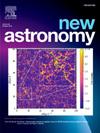在 REBOUND 中对不同物体之间的碰撞进行构图跟踪
IF 1.9
4区 物理与天体物理
Q2 ASTRONOMY & ASTROPHYSICS
引用次数: 0
摘要
以往的研究表明,行星形成后期行星胚胎和行星基本体之间的撞击通常可以决定一个系统中新形成行星的内核和地幔物质的组成比例。以往的研究试图将这些碰撞对成分改变的影响纳入行星形成的 N-体模拟中,通常是作为后处理代码。在本文中,我们将介绍 "差异体成分跟踪器"(Differentiated Body Composition Tracker),这是一种新的后处理工具,它使用从 N-body 积分器 REBOUND 收集到的碰撞数据来确定在碰撞过程中在碰撞物体和产生的碎片之间转移的核心和地幔物质的数量。我们利用 50 个 REBOUND 模拟行星形成的数据演示了该代码的工作原理,并探讨了代码中的参数如何影响这些模拟中剩余天体的核心质量分数。然后,我们研究了内核物质在初始圆盘上的非均匀分布如何影响行星的最终内核质量分数。我们发现,在理想条件下,巨型撞击和内核物质丰富的行星胚胎相结合,可以产生一些已经发现的富铁行星。本文章由计算机程序翻译,如有差异,请以英文原文为准。
Composition tracking for collisions between differentiated bodies in REBOUND
Previous research suggests that impacts between planetary embryos and planetesimals during the late stages of planet formation can often determine the percentages of core and mantle material that compose the newly formed planets in a system. Previous studies have attempted to include the composition-changing effects of these collisions in N-body simulations of planet formation, often as post-processing codes. In this paper, we present the Differentiated Body Composition Tracker, a new post-processing tool that uses collisional data collected from the N-body integrator REBOUND to determine the amount of core and mantle material that is transferred between colliding objects and the resulting fragments during an impact. We demonstrate how this code works using the data from 50 REBOUND simulations of planet formation and explore how the parameters in the code affect the core mass fractions of the remaining objects from these simulations. We then investigate how non-uniform distributions of core material across an initial disc affect the final core mass fractions of planets. Under ideal conditions, we find that a combination of giant impacts and planetary embryos enriched in core material could create some of the iron-rich planets that have been discovered.
求助全文
通过发布文献求助,成功后即可免费获取论文全文。
去求助
来源期刊

New Astronomy
地学天文-天文与天体物理
CiteScore
4.00
自引率
10.00%
发文量
109
审稿时长
13.6 weeks
期刊介绍:
New Astronomy publishes articles in all fields of astronomy and astrophysics, with a particular focus on computational astronomy: mathematical and astronomy techniques and methodology, simulations, modelling and numerical results and computational techniques in instrumentation.
New Astronomy includes full length research articles and review articles. The journal covers solar, stellar, galactic and extragalactic astronomy and astrophysics. It reports on original research in all wavelength bands, ranging from radio to gamma-ray.
 求助内容:
求助内容: 应助结果提醒方式:
应助结果提醒方式:


